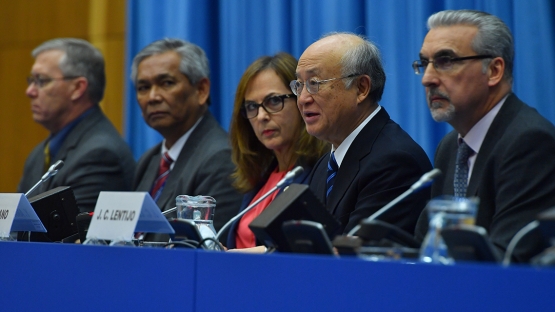Experts Share Ideas to Strengthen Physical Protection of Nuclear Material at IAEA Conference

The IAEA plans to reflect the new ideas in future guidance,
IAEA Director General Yukiya Amano said in Vienna last Friday at the
closing of the International Conference on the Physical Protection of
Nuclear Material and Nuclear Facilities. (Photo: D. Calma/IAEA)
Last week, some 700 participants shared ideas, experiences
and best practices to further enhance the physical protection of nuclear
material and facilities against theft or sabotage. The IAEA plans to
reflect the ideas in future guidance, IAEA Director General Yukiya
Amano said at the closing of the conference in Vienna last Friday.
“Physical protection of nuclear material and nuclear facilities is a key element of national nuclear security regimes,” Mr Amano said. “All countries, and organizations such as the IAEA, must work together to ensure that physical protection is sufficient to meet evolving threats.”
Mr Amano highlighted the support Member States can obtain from the IAEA under the IAEA Nuclear Security Plan 2018-2021, adopted by the Board of Governors in September. This includes comprehensive guidance on nuclear security, physical protection upgrade assistance, peer review and advisory missions, and training and education on nuclear security to its Member States.
Participants also discussed the status of the Convention on the Physical Protection of Nuclear Material and its Amendment, which entered into force last year, and which expands the original Convention, adopted in 1979, to cover the protection of nuclear facilities and nuclear material in domestic use, storage and transport. Of the 155 signatories of the CPPNM, 115 have so far adhered to the Amendment. “I encourage all countries that have not yet done so to adhere to it,” Mr Amano said.
Besides the lectures and discussions, on the sidelines of the conference several institutions presented innovative equipment including safety masks and radiation detection devices. The conference also featured digital interactive content presentations which allowed participants to learn about different nuclear security areas using touch-screen displays.
A 3D virtual reality tool offered participants an opportunity to jump into the shoes of a fictitious criminal and allowed them to simulate an attempt to break into a nuclear power plant.
“The idea of this tool is to train people about the interaction between physical and cyber security,” said Scott Godwin, general manager of the National Security Directorate at the Pacific Northwest National Laboratory, where the new Immersive Training Platform was developed. “It allows you to go through the different security barriers, both physical and digital, in a realistic environment, and explore weaknesses that might exist in the security regime. During the experience, we are able to pause the virtual reality training and outline common defensive mechanisms to stop the threat.”
The Conference was held in cooperation with the International Criminal Police Organization (INTERPOL), the World Nuclear Transport Institute and the World Institute for Nuclear Security.
“Physical protection of nuclear material and nuclear facilities is a key element of national nuclear security regimes,” Mr Amano said. “All countries, and organizations such as the IAEA, must work together to ensure that physical protection is sufficient to meet evolving threats.”
All countries, and organizations such as the IAEA, must work together to ensure that physical protection is sufficient to meet evolving threats.The IAEA is the global platform through which countries cooperate to minimize the risk of nuclear and other radioactive material being used in a malicious way, Mr Amano said, adding that the International Conference on the Physical Protection of Nuclear Material and Nuclear Facilities was an excellent example of this cooperation. “I am grateful to all of you for being part of this effort to strengthen nuclear security.”
Mr Amano highlighted the support Member States can obtain from the IAEA under the IAEA Nuclear Security Plan 2018-2021, adopted by the Board of Governors in September. This includes comprehensive guidance on nuclear security, physical protection upgrade assistance, peer review and advisory missions, and training and education on nuclear security to its Member States.
Participants also discussed the status of the Convention on the Physical Protection of Nuclear Material and its Amendment, which entered into force last year, and which expands the original Convention, adopted in 1979, to cover the protection of nuclear facilities and nuclear material in domestic use, storage and transport. Of the 155 signatories of the CPPNM, 115 have so far adhered to the Amendment. “I encourage all countries that have not yet done so to adhere to it,” Mr Amano said.
Besides the lectures and discussions, on the sidelines of the conference several institutions presented innovative equipment including safety masks and radiation detection devices. The conference also featured digital interactive content presentations which allowed participants to learn about different nuclear security areas using touch-screen displays.
A 3D virtual reality tool offered participants an opportunity to jump into the shoes of a fictitious criminal and allowed them to simulate an attempt to break into a nuclear power plant.
“The idea of this tool is to train people about the interaction between physical and cyber security,” said Scott Godwin, general manager of the National Security Directorate at the Pacific Northwest National Laboratory, where the new Immersive Training Platform was developed. “It allows you to go through the different security barriers, both physical and digital, in a realistic environment, and explore weaknesses that might exist in the security regime. During the experience, we are able to pause the virtual reality training and outline common defensive mechanisms to stop the threat.”
The Conference was held in cooperation with the International Criminal Police Organization (INTERPOL), the World Nuclear Transport Institute and the World Institute for Nuclear Security.

No comments:
Post a Comment